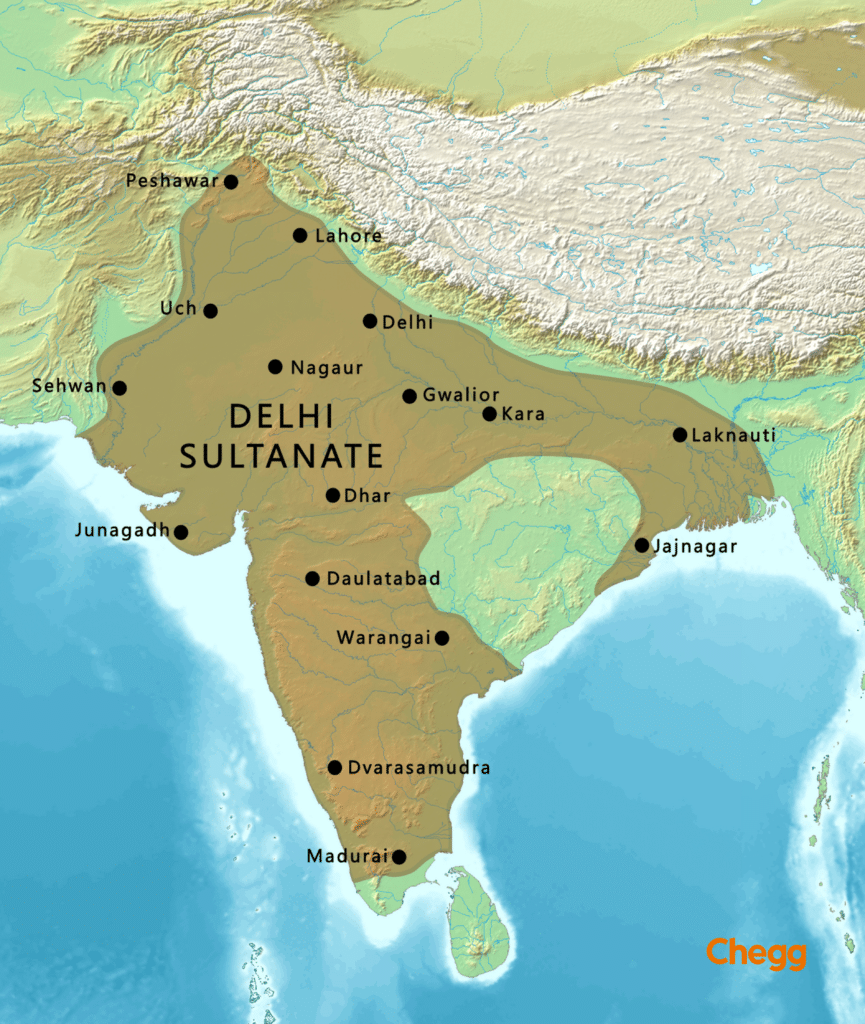The Delhi Sultanate (1206–1526) and Bengal Sultanate (1338–1576) were significant Muslim-ruled polities in medieval India, each shaping the political, cultural, and social landscape of their regions.
Delhi Sultanate (1206–1526)
Overview:
- Foundation: Established by Qutb-ud-din Aibak, a former slave of Muhammad of Ghor, after the Ghurid conquest of northern India.
- Dynasties: Five major dynasties ruled—Slave (1206–1290), Khalji (1290–1320), Tughlaq (1320–1413), Sayyid (1414–1451), and Lodi (1451–1526).
- Territory: At its peak (under Alauddin Khalji and Muhammad bin Tughlaq), it spanned most of northern and central India, with influence extending southward.
Key Features:
- Administration: Centralized governance with a mix of Persian, Central Asian, and Indian elements. Iqta system (land grants for military service) was central. Sultans like Alauddin Khalji introduced market reforms and revenue systems.
- Military: Relied on cavalry, Turkic and Afghan warriors, and fortifications. Faced Mongol invasions, which they largely repelled.
- Culture: Synthesis of Indo-Islamic culture. Persian was the court language; Urdu began emerging. Architectural landmarks include Qutb Minar, Alai Darwaza, and Tughlaqabad Fort.
- Religion: Islam was the state religion, but policies toward Hindus varied. Some rulers (e.g., Firuz Shah Tughlaq) imposed jizya, while others were more tolerant.
Decline:
- Weak successors, internal revolts, and regional fragmentation (e.g., rise of Bengal and Vijayanagara). The Lodi dynasty fell to Babur’s Mughal invasion at the First Battle of Panipat (1526).
Bengal Sultanate (1338–1576)
Overview:
- Foundation: Emerged as an independent entity under Shamsuddin Ilyas Shah, who consolidated power after breaking from Delhi’s Tughlaq rule.
- Territory: Covered modern-day Bengal, parts of Bihar, Odisha, and Assam. A key maritime and trade hub.
- Dynasties: Ilyas Shahi (1338–1414, 1435–1487), Ganesha dynasty (briefly), and Hussain Shahi (1493–1538) were prominent.
Key Features:
- Economy: Thrived on trade, especially textiles, rice, and maritime commerce with Southeast Asia, China, and the Middle East. Gaur and Pandua were major urban centers.
- Administration: Adapted Delhi’s systems but with greater local influence. Governors and nobles had significant autonomy.
- Culture: A vibrant Indo-Islamic culture emerged. Bengali literature flourished (e.g., under Hussain Shahi rulers). Mosques like Adina Masjid and mausoleums reflected Persian and local architectural styles.
- Religion: Islam spread, but Bengal’s rulers often pursued pragmatic policies, patronizing Hindu elites and Bengali traditions. Sufism played a key role in conversions.
Decline:
- Internal strife and Afghan resurgence (under Sher Shah Suri) weakened the sultanate. The Mughals under Akbar annexed Bengal by 1576, ending its independence.
Relationship Between Delhi and Bengal
- Bengal was initially under Delhi’s control but gained independence during the Tughlaq dynasty’s decline. Delhi occasionally attempted to reassert authority (e.g., Firuz Shah Tughlaq’s campaigns), but Bengal’s rulers maintained autonomy.
- Both sultanates shared Turkic-Persian administrative traditions but diverged culturally, with Bengal developing a distinct regional identity tied to its language and trade.
Legacy
- Delhi Sultanate: Laid the foundation for Mughal rule, introduced Indo-Islamic architecture, and shaped northern India’s Muslim polity.
- Bengal Sultanate: Fostered Bengali identity, enriched regional literature, and integrated Bengal into global trade networks.




0 Comments